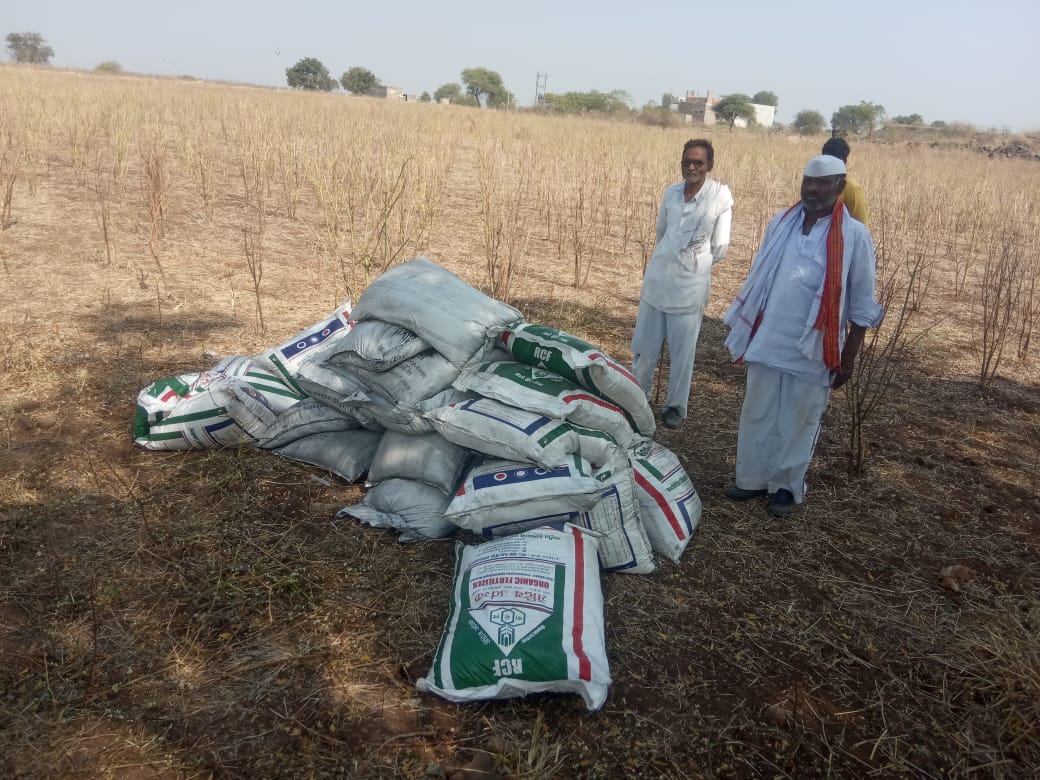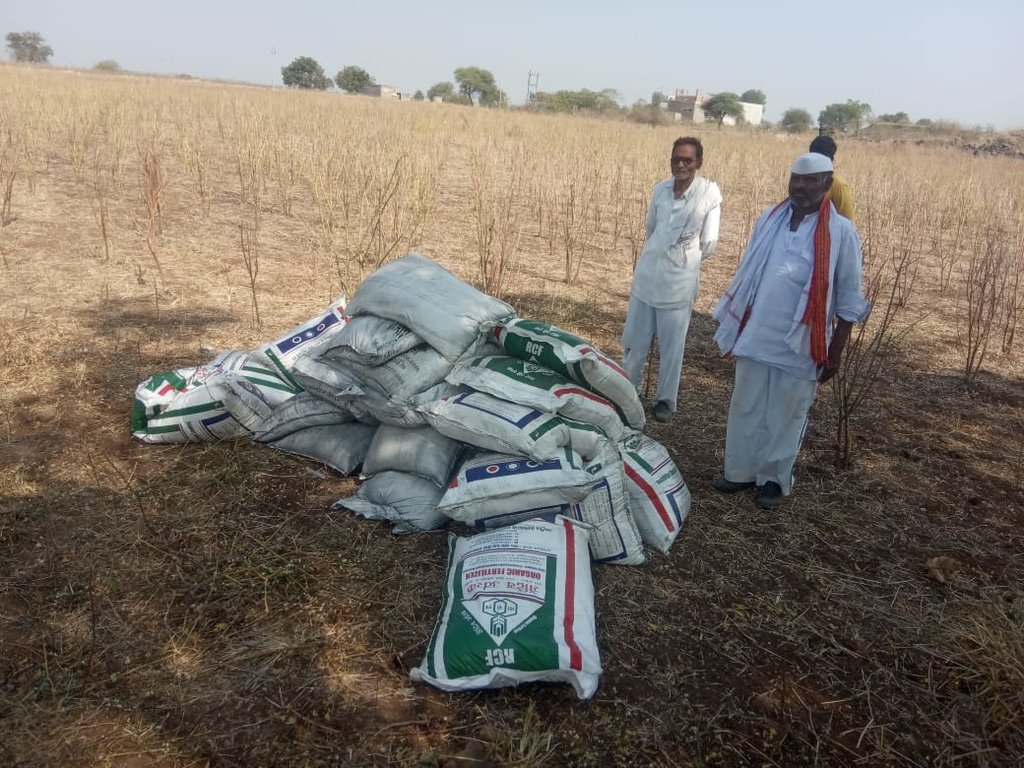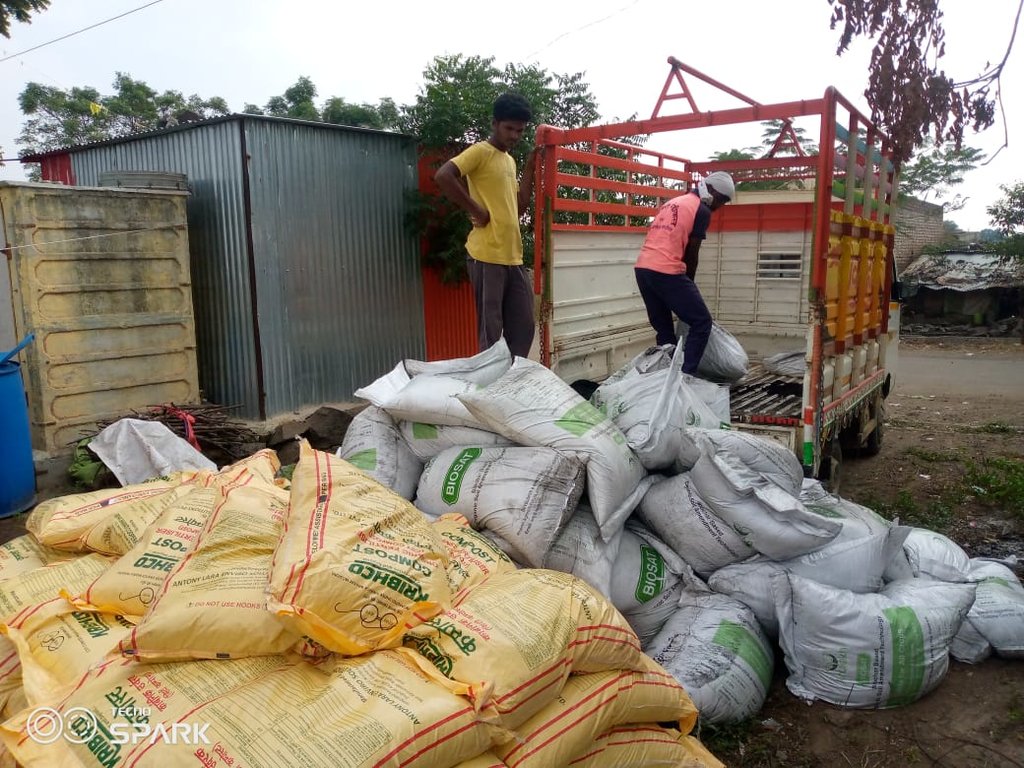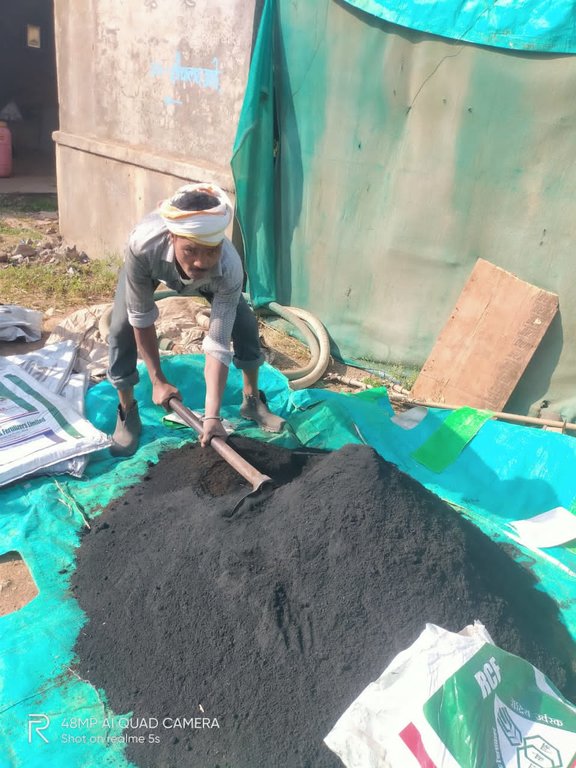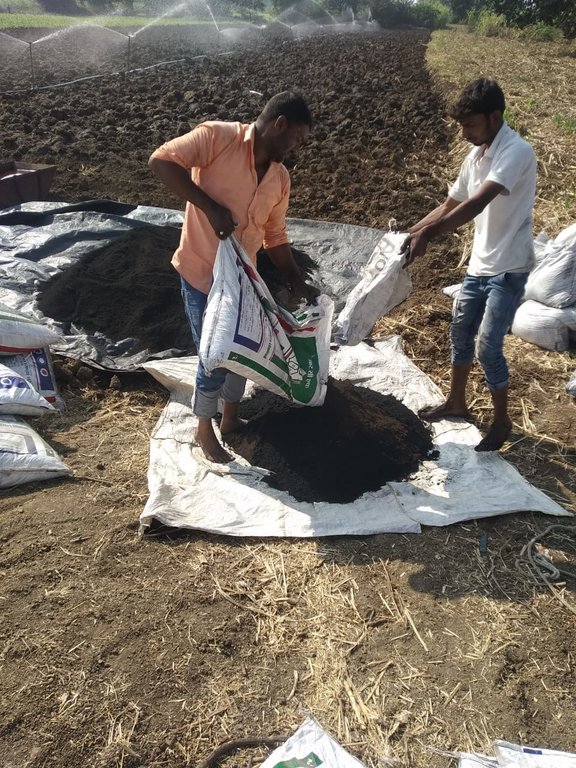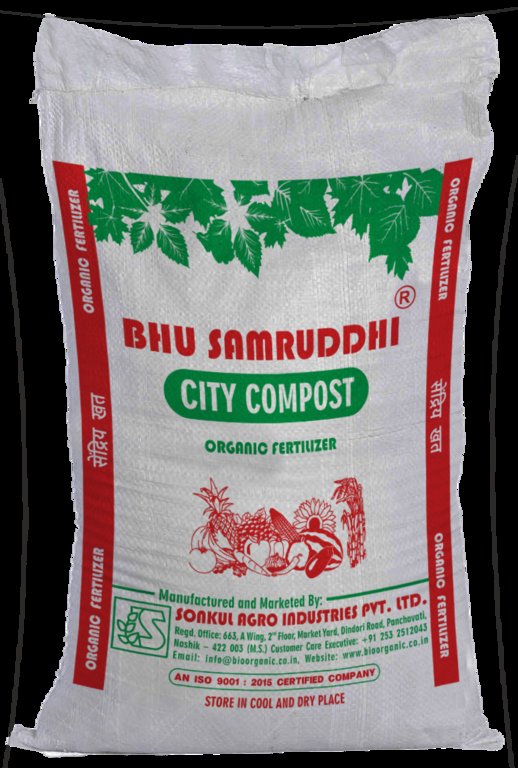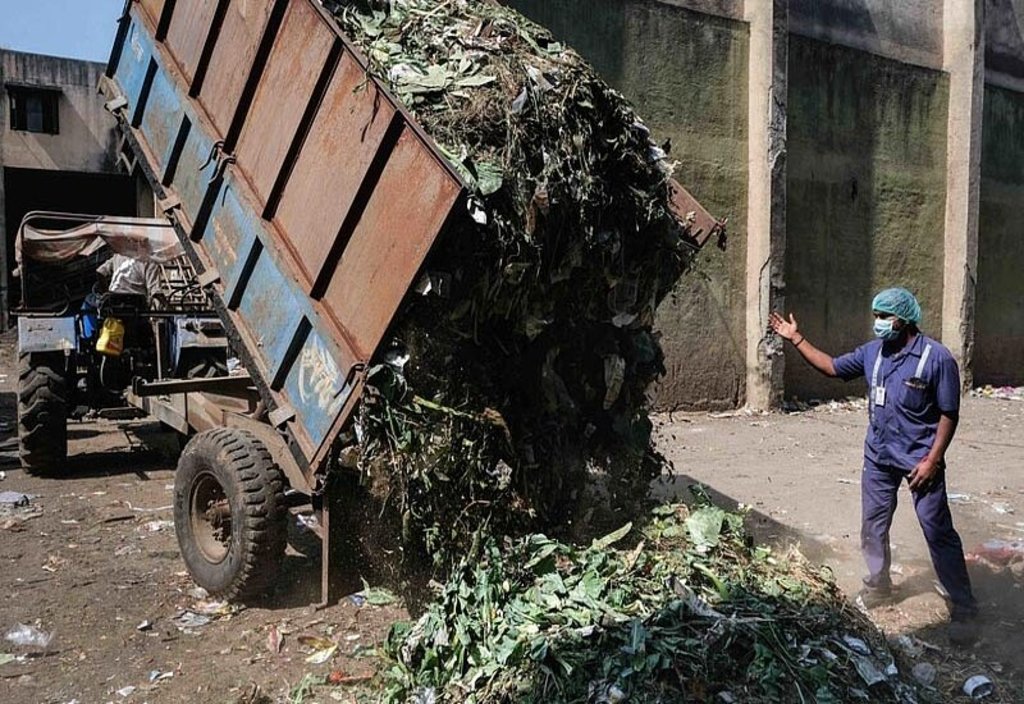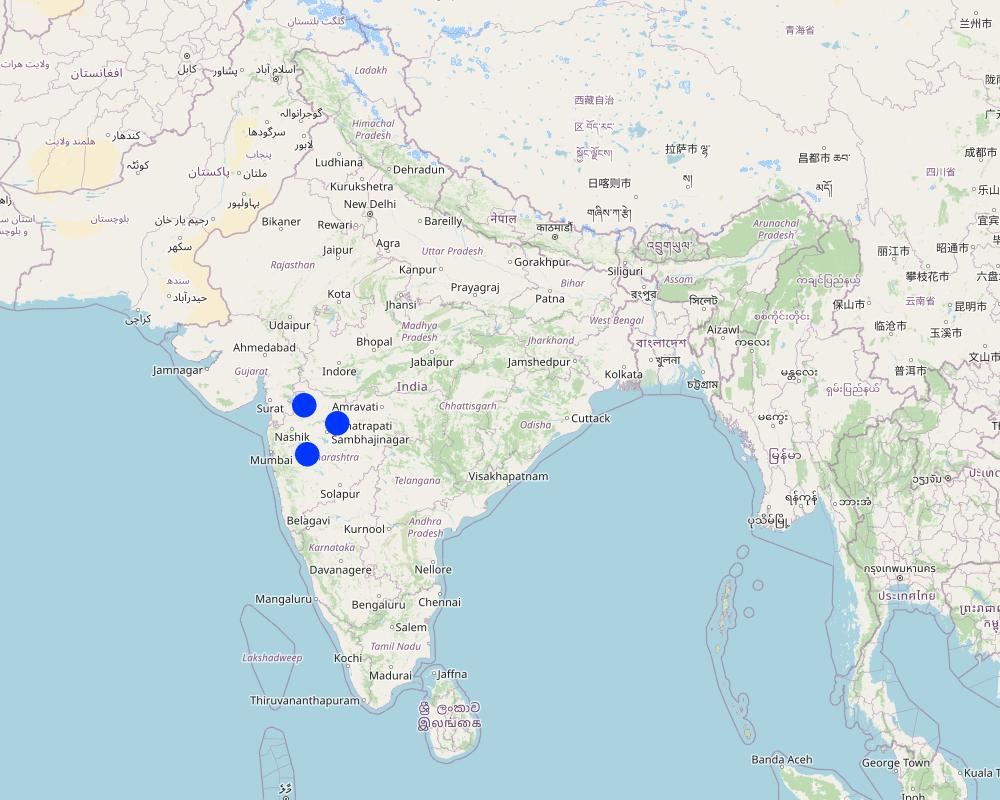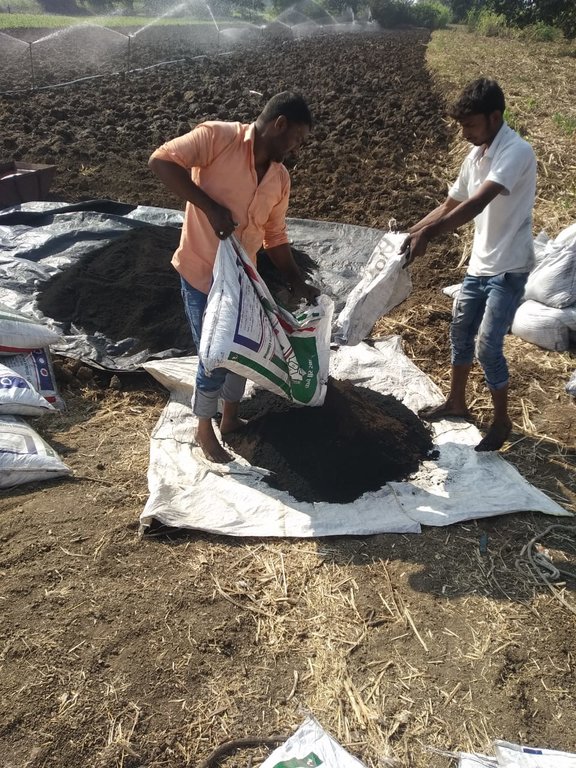City Compost: A Solution For Waste Management And Soil Health Improvement [الهند]
- تاريخ الإنشاء:
- تحديث:
- جامع المعلومات: Santosh Gupta
- المحررون: Noel Templer, Stephanie Katsir
- المراجعون: Udo Höggel, Joana Eichenberger
Khachra Khad
technologies_6728 - الهند
- City Compost: A Solution For Waste Management And Soil Health Improvement: 3 أكتوبر، 2023 (inactive)
- City Compost: A Solution For Waste Management And Soil Health Improvement: 9 أكتوبر، 2023 (inactive)
- City Compost: A Solution For Waste Management And Soil Health Improvement: 17 إبريل، 2024 (public)
عرض الأقسام
توسيع الكل طي الكل1. معلومات عامة
1.2 تفاصيل الاتصال بالأشخاص الرئيسيين لمصدر المعلومات والمؤسسات المشاركة في تقييم وتوثيق التقنية
اسم المشروع الذي سهّل توثيق/تقييم التقنية (إذا كان ذلك على صلة)
Soil protection and rehabilitation for food security (ProSo(i)l)اسم المؤسسة (المؤسسات) التي سهلت توثيق/تقييم التقنية (إذا كان ذلك على صلة)
Deutsche Gesellschaft für Internationale Zusammenarbeit (GIZ) GmbH (GIZ) - ألمانيااسم المؤسسة (المؤسسات) التي سهلت توثيق/تقييم التقنية (إذا كان ذلك على صلة)
Alliance Bioversity and International Center for Tropical Agriculture (Alliance Bioversity-CIAT) - كينيااسم المؤسسة (المؤسسات) التي سهلت توثيق/تقييم التقنية (إذا كان ذلك على صلة)
Ecociate Consultants (Ecociate Consultants) - الهند1.3 الشروط المتعلقة باستخدام البيانات الموثقة من خلال WOCAT
يوافق جامع المعلومات والشخص (لاشخاص) الرئيسي لمصدر المعلومات على الشروط المتعلقة باستخدام البيانات الموثقة من خلال WOCAT:
نعم
1.4 إعلان بشأن استدامة التقنية الموصوفة
هل التقنية الموصوفة هنا تمثل مشكلة فيما يتعلق بتدهور الأراضي، بحيث لا يمكن إعلانها تقنية مستدامة لإدارة الأراضي؟:
كلا
التعليقات:
The application of city compost improves the soil health
2. وصف تقنيةالإدارة المستدامي للأراضي
2.1 وصف مختصر للتقنية
تعريف التقنية:
The use of city compost is a sustainable solution for addressing the problem of waste management and soil degradation. Under this technology, urban municipal waste is composted and used as organic fertiliser in agriculture. This relieves the cities’ waste management, enhances rural soils and in turn improves farm productivity.
2.2 وصف تفصيلي للتقنية
الوصف:
In India, over 377 million people live in almost 8,000 cities or towns. They generate 62 million tons of municipal solid waste annually, according to the country’s government. More than 80% of such solid waste is deposited indiscriminately without treatment at dump yards in an unhygienic manner. In the Indian countryside, the ecological sustainability of agriculture has been at risk due to the excessive use of chemical fertilizers and monoculture since the ‘Green Revolution’ led to the degradation of land.
City compost is one of the solutions to both problems. Waste collected by municipal corporations is processed to make compost. During this process, organic waste is collected in the cities, recycled, processed to compost, and finally used as organic matter by farmers complementing the traditional farmyard manure. In such manner carbon that is contained in the waste is recycled back into the soil thus enhancing agricultural production.
Nashik Municipal Corporation in Nashik town of Maharashtra State in India has set-up a waste processing plant in the town. This plant processes the city’s organic waste into compost through a scientific process. The processed city compost is packed into bags of 50 kg each and these bags are supplied to fertilizer companies and further on to farmers. There are Government subsidies available to farmers for the purchase of compost bags subject to documentary proofs and other conditions.
Under the “Soil Protection and Rehabilitation for Food Security (ProSoil)” project of GIZ, farmers and FPOs (farmer producer organizations) have been supported for the application of city compost in their fields. Supported by the implementing agency WOTR (Watershed Organization Trust) the city compost application in farmer's fields in 3 districts of Maharashtra namely Ahmednagar, Jalna and Dhule has been introduced. Interventions covered more than 3000 farmers and around 1100 Acres of land. The entire intervention is implemented with the help of FPOs, which procured the city compost from ‘The Nashik Waste Management Centre’ and sold the procured material further to the farming communities. This has ensured easy availability to the farmers without incurring undue travel cost. Farmers applied the city waste compost in their farms during the month of May/June (before the onset of monsoon) to different crops.
City compost was applied to different crop combinations such as paddy-chickpea in Dhule District (moderate irrigation facility), greengram-sorghum in Ahmed Nagar District (Rainfed conditions) and soyabean-wheat in Jalna District (irrigated conditions). Farmers have seen the benefits of city compost across all crop combinations and geographies. The application of city compost has been of benefit to farmers in reducing the usage of synthetic fertilizers along with reducing the dependency on farmyard manure as it is getting scarce day by day. Farmers have also realized the improved soil health leading to better productivity of their farms.
The Indian government has also launched several initiatives to promote the use of city compost in agriculture. For example, the National Mission for Sustainable Agriculture provides financial assistance to farmers for the purchase of city compost, and the Fertilizer Control Order allows the use of city compost as a fertilizer. Although developing city waste as compost and its application in the farmer's field is a nascent approach from the India Government and other stakeholders, however looking at the availability of waste, the commitment of the Indian Government through its ‘Clean India Program’ and the vast issue of synthetic fertilizers usage and high subsidy burden, the use of city compost in agriculture has the potential to contribute to sustainable solutions in the area of waste management while improving soil health and reducing the use of synthetic fertilizers in India.
2.3 صور التقنية
2.4 فيديوهات عن التقنية
تعليقات، وصف موجز:
https://www.youtube.com/watch?v=Jms1dp3DABU
2.5 البلد/المنطقة/المواقع التي تم تنفيذ التقنية فيها والتي يغطيها هذا التقييم
البلد:
الهند
المنطقة/الولاية/المحافظة:
Maharashtra
مزيد من التفاصيل حول الموقع:
Ahmednagar, Jalna, Dhule
حدد انتشار التقنية:
- يتم تطبيقها في نقاط محددة/ تتركز على مساحة صغيرة
هل يقع موقع/مواقع التقنية في منطقة محمية بشكل دائم؟:
كلا
التعليقات:
The intervention is implemented with around 1100 farmers across the 3 districts namely Ahmednagar, Jalna and Dhule in the Indian state of Maharashtra
Map
×2.6 تاريخ التنفيذ
اذكر سنة التنفيذ:
2021
2.7 إدخال التقنية
حدد كيف تم إدخال التقنية:
- أثناء التجارب/الأبحاث
- من خلال المشاريع/ التدخلات الخارجية
التعليقات (نوع المشروع، الخ):
Developing city compost is a result of research by various agencies. However, the application of the city compost technology is part of the Pro-Soil project of GIZ.
3. تصنيف تقنية الإدارة المستدامي للأراضي
3.1 الغرض الرئيسي ( الأغراض الرئيسية) للتقنية
- تحسين الإنتاج
- الحد من تدهور الأراضي ومنعه وعكسه
- خلق أثر اقتصادي مفيد
- Reduce municipal waste
3.2 نوع (أنواع) استخدام الأراضي الحالية حيث يتم تطبيق التقنية
استخدامات الأراضي مختلطة ضمن نفس وحدة الأرض:
كلا

الأراضي الزراعية
- زراعة سنوية
الزراعة السنوية - حدد المحاصيل:
- الحبوب - الأرز (في الأراضي المرتفعة)
- الحبوب - الذرة الرفيعة
- الحبوب - قمح (شتوي)
- الحبوب البقولية والبقول- الفاصوليا
- الحبوب البقولية والبقول -فول الصويا
عدد مواسم الزراعة في السنة:
- 2
حدد:
Paddy-Chickpea, Greengram-Sorghum, Soybean-Wheat
هل يتم ممارسة الزراعة البينية؟:
نعم
إذا كانت الإجابة بنعم، حدد المحاصيل التي يتم زراعتها بشكل بيني:
Maize, Vegetables, Fodder crops
هل تتم ممارسة تناوب المحاصيل؟:
نعم
إذا كانت الإجابة بنعم، حدد:
Mostly rotation happens during the winter crops. Chick-pea is replaced with gram or beans are replaced with other vegetables
التعليقات:
The intervention is mostly applied on cropland.
3.3 هل تغير استخدام الأراضي نتيجة لتنفيذ التقنية؟
هل تغير استخدام الأراضي نتيجة لتنفيذ التقنية؟:
- لا (تابع مع السؤال 3.4)
3.4 إمدادات المياه
إمدادات المياه للأرض التي يتم تنفيذ التقنية عليها:
- مختلط بعلي-مروي
التعليقات:
The rainfall pattern varied from location to location and farmer to farmer depending upon the accessibility to canals and availability of resources to lift the ground water. Most farmers in Ahmednagar are rainfed farmers while in Jalna they have some irrigation facilities.
3.5 مجموعةالإدارة المستدامة للأراضي التي تنتمي إليها هذه التقنية
- أنظمة التناوب (تعاقب المحاصيل، البور، الزراعة المتنقلة)
- الإدارة المتكاملة لخصوبة التربة
- إدارة النفايات / إدارة مياه الصرف الصحي
3.6 التدابير التقنية في مجال إلادارة المستدامة للأراضي

التدابير الزراعية
- A2: المادة العضوية/خصوبة التربة
التعليقات:
Application of city compost is an agronomic measure as it needs to be applied every year and is closely linked to the agricultural cycle. The application of city compost adds organic matter to the soil and improves the soil fertility.
3.7 الأنواع الرئيسية من تدهور الأراضي التي تناولتها التقنية

التدهور الكيميائي للتربة
- (Cn): تراجع الخصوبة وانخفاض محتوى المادة العضوية (غير ناتج عن الانجراف)
التعليقات:
Application of city compost can significantly reduce the usage of chemical fertilisers in the soil as it can supply the required nutrients to the soil. It is also a relatively cheap option.
3.8 منع أو حد أو عكس تدهور الأراضي
تحديد هدف التقنية فيما يتعلق بتدهور الأراضي:
- اصلاح/إعادة تأهيل الأراضي المتدهورة بشدة
4. المواصفات الفنية، وأنشطة التنفيذ، والمدخلات، والتكاليف
4.1 الرسم الفني للتقنية
4.2 معلومات عامة بخصوص حساب المدخلات والتكاليف
حدد كيفية احتساب التكاليف والمدخلات:
- حسب مساحة تنفيذ التقنية
الإشارة إلى حجم ووحدة المساحة:
Hectare
عملة أخرى/ عملة وطنية (حدد):
INR
إذا كان ذا صلة، وضح سعر الصرف من الدولار الأمريكي إلى العملة المحلية (على سبيل المثال، 1 دولار أمريكي = 79.9 ريال برازيلي): 1 دولار أمريكي =:
80,0
اذكر متوسط تكلفة أجر العمالة المستأجرة في اليوم الواحد:
200
4.3 أنشطة التأسيس
التعليقات:
There are no establishment activities involved in the intervention as farmers are buying the city compost and applying it annually in their fields. The establishment of city compost plant is out of the purview of farmers and their institution.
4.4 التكاليف والمدخلات اللازمة للتأسيس
التعليقات:
There is no establishment cost involved in the intervention as farmers are buying the city compost and applying annually in their fields. The establishment of a city compost plant is out of the purview of farmers and their institutions.
4.5 الصيانة/الأنشطة المتكررة
| النشاط | التوقيت/الوتيرة | |
|---|---|---|
| 1. | Purchase of city compost by FPO and transportation to the base location | April/May |
| 2. | Selling of the city compost among the farmers | May |
| 3. | Application of city compost in the field by farmers | May or early June |
| 4. | Mixing of the city compost in soil using the cultivator or rotavator | May/June (Immediately after the application) |
| 5. | Irrigation of the field | Mid June or at the onset of Monsoon (farmers having assured irrigation due with their own sources) |
| 6. | Sowing of the seeds | June or early July |
| 7. | Intercultural operations (Weeding, nutrient management, pest application, crop monitoring) | July-October |
| 8. | Harvesting of the crops | October/November |
التعليقات:
The timing of these activities may vary a bit based on the crops sown by the farmers or the onset of monsoon rains
4.6 التكاليف والمدخلات اللازمة للصيانة/للأنشطة المتكررة (سنويًا)
| تحديد المدخلات | الوحدة | الكمية | التكاليف لكل وحدة | إجمالي التكاليف لكل مدخل | % من التكاليف التي يتحملها مستخدمو الأراضي | |
|---|---|---|---|---|---|---|
| العمالة | Application of city compost | Person days | 2,0 | 300,0 | 600,0 | 100,0 |
| العمالة | Irrigation | Person days | 2,0 | 300,0 | 600,0 | 100,0 |
| معدات | Hired machinery for mixing the city compost in soil | Hours | 2,0 | 900,0 | 1800,0 | 100,0 |
| الأسمدة والمبيدات الحيوية | City compost | Ton | 2,5 | 1200,0 | 3000,0 | 100,0 |
| إجمالي تكاليف صيانة التقنية | 6000,0 | |||||
| إجمالي تكاليف صيانة التقنية بالدولار الأمريكي | 75,0 | |||||
التعليقات:
The cost towards other operations such as sowing, intercultural operations, pest management and harvesting is not covered here as these costs are not directly associated with the documented intervention.
4.7 أهم العوامل المؤثرة على التكاليف
قدم وصفا لأهم العوامل التي تؤثر على التكاليف:
The cost of city compost is available at a subsidised price of INR 1000 per ton incl. transportation. Non-subsidised prices range at INR 3000 per ton plus transportation. Project farmers could get it at subsidised rates. However, the non-availability of required documents may be a hindrance for farmers to avail the subsidised prices.
5. البيئة الطبيعية والبشرية
5.1 المناخ
هطول الأمطار السنوي
- < 250 مم
- 251- 500 ملم
- 501 - 750ملم
- 1,000-751 ملم
- 1,500-1,100 ملم
- 2,000-1,500 ملم
- 3,000-2,001 ملم
- 4,000-3,100 ملم
- > 4000 ملم
حدد متوسط هطول الأمطار السنوي (إذا كان معروفًا)، بالملليمتر:
566,00
المواصفات/التعليقات على هطول الأمطار:
On an average, there are 34 rainy days (i.e. days with rainfall of 2.5 mm or more) in a year in the district. The major rainfall is usually received during months of June to September.
الإشارة إلى اسم محطة الأرصاد الجوية المرجعية المعنية:
IMD, Pune
المنطقة المناخية الزراعية
- شبه قاحلة
The project area comes under the scarcity zone, which is characterised by very low and erratic nature of rainfall, this affects the moisture content in the soil, therefore, this zone is commonly known as a drought-prone area. There is a high scarcity of irrigation water after the month of December. Thus, farmers mostly cultivate crops which can withstand very low water supplies.
5.2 طوبوغرافيا
متوسط الانحدارات:
- مسطح (0-2%)
- بسيط (3-5%)
- معتدل (6-10%)
- متدحرج (11-15%)
- تلال (16-30%)
- شديدة الانحدار(31-60%)
- فائقة الانحدار (>60%)
التضاريس:
- هضاب/سهول
- أثلام مرتفعة
- المنحدرات الجبلية
- منحدرات التلال
- منحدرات في السفوح
- قاع الوادي
المنطقة الارتفاعية:
- 100-0 متر فوق سطح البحر
- 500-101 متر فوق سطح البحر
- 1,000-501 متر فوق سطح البحر
- 1,500-1,001 متر فوق سطح البحر
- 2,000-1,501 متر فوق سطح البحر
- 2,500-2,100 متر فوق سطح البحر
- 3,000-2,501 متر فوق سطح البحر
- 4,000-3,001 متر فوق سطح البحر
- > 4000 متر فوق سطح البحر
وضح ما إذا كانت التقنية مطبقة على وجه التحديد في:
- غير ذات صلة
التعليقات والمواصفات الإضافية بشأن التضاريس:
The altitude of district ranges from 500 to 750 meter above sea level. Except a little over 4% area, most part of the district is plain area.
5.3 التربة
متوسط عمق التربة:
- ضحل جدًا (0-20 سم)
- ضحلة (21-50 سم)
- متوسطة العمق (51-80 سم)
- عميقة (81-120 سم)
- عميقة جدًا (> 120 سم)
قوام التربة (التربة السطحية):
- متوسط ( طميي، سلتي)
قوام التربة (> 20 سم تحت السطح):
- متوسط ( طميي، سلتي)
المواد العضوية في التربة السطحية:
- منخفضة (<1%)
إذا كان متاحًا، قم بإرفاق وصف كامل للتربة أو تحديد المعلومات المتوفرة، على سبيل المثال نوع التربة، الرقم الهيدروجيني/ درجة حموضة التربة، قدرة التبادل الكاتيوني، النيتروجين، الملوحة وما إلى ذلك.
Soils vary from reddish brown to dark grey and are commonly grouped as light to medium black soils. In very few places deep black soil is also observed.
5.4 توافر المياه ونوعيتها
منسوب المياه الجوفية:
> 50 م
توافر المياه السطحية:
ضعيف/ غير متوافر
نوعية المياه (غير المعالجة):
للاستخدام الزراعي فقط (الري)
تشير جودة المياه إلى:
المياه الجوفية
هل تعتبر ملوحة الماء مشكلة؟:
نعم
حدد:
As per the water samples collected by the Central Ground Water Board, 73% samples were reported as high salinity water (EC in the range of 750-2250 qS/cm). Please refer to: (http://cgwb.gov.in/District_Profile/Maharashtra/Ahmadnagar.pdf
هل تحدث فيضانات في المنطقة؟:
كلا
تعليقات ومواصفات أخرى بشأن نوعية المياه وكميتها:
A large majority of the area is a water scarce area with a dry long spell being a common feature. As indicated above the quality of water is also poor, which makes it even unusable for irrigation. During the last couple of years there has been enormous efforts to develop the surface water harvesting infrastructure in project areas.
5.5 التنوع البيولوجي
تنوع الأنواع:
- منخفض
تنوع الموائل:
- متوسط
التعليقات والمواصفات الإضافية بشأن التنوع البيولوجي:
The western hilly part of Ahmednagar District has forests. Teak, Babul, Dhavada, Haldu and Neem are trees found in these forests. Fruit trees like Mango, Tamarind, Amala, Bor are also found in the District.
5.6 خصائص مستخدمي الأراضي الذين يطبقون التقنية
مستقر أو مرتحل:
- غير المترحل
التوجه السوقي لنظام الإنتاج:
- مختلط (كفاف/ تجاري)
الدخل من خارج المزرعة:
- 10-50% من جميع الإيرادات
المستوى النسبي للثروة:
- متوسط
أفراداً أو مجموعات:
- فرد/أسرة معيشية
- تعاونية
مستوى المكننة:
- الجر الحيواني
- ميكانيكية/ مزودة بمحرك
الجنس:
- نساء
- رجال
عمر مستخدمي الأرضي:
- شباب
- متوسط العمر
اذكر الخصائص الأخرى ذات الصلة لمستخدمي الأراضي:
Due to poor rainfall patterns and non-availability of irrigation, most farmers are in a position to cultivate only 1-2 food crops in the year. The prevalence of cash crops is very minimal. Farmers have been grouped into 4 farmer-producer organisations formed under the Pro-Soil Project. All of these groups have a good representation of women farmers.
5.7 متوسط مساحة الأرض التي يستخدمها مستخدمو الأراضي الذين يطبقون التقنية
- < 0.5 هكتارا
- 0.5 - 1 هكتار
- 1 -2 هكتار
- 2 - 5 هكتار
- 5 - 15 هكتار
- 15 - 50 هكتار
- 50 - 100هكتار
- 500-100 هكتار
- 1,000-500 هكتار
- 10,000-1,000 هكتار
- > 10,000 هكتار
هل يعتبر هذا نطاقًا صغيرًا أو متوسطًا أو واسعا (في إشارة إلى السياق المحلي)؟:
- على نطاق صغير
التعليقات:
A large majority of the land users are small and marginal farmers
5.8 ملكية الأراضي، وحقوق استخدام الأراضي، وحقوق استخدام المياه
ملكية الارض:
- فردية، يوجد سند ملكية
حقوق استخدام الأراضي:
- فردي
حقوق استخدام المياه:
- مجتمعي (منظم)
- فردي
هل تعتمد حقوق استخدام الأراضي على نظام قانوني تقليدي؟:
نعم
التعليقات:
All the project farmers have land titles either in their name or their family members' name. These land rights are transferred among the family members as part of the Indian land transfer systems.
5.9 الوصول إلى الخدمات والبنية التحتية
الصحة:
- ضعيف
- معتدل
- جيد
التعليم:
- ضعيف
- معتدل
- جيد
المساعدة التقنية:
- ضعيف
- معتدل
- جيد
العمل (على سبيل المثال خارج المزرعة):
- ضعيف
- معتدل
- جيد
الأسواق:
- ضعيف
- معتدل
- جيد
الطاقة:
- ضعيف
- معتدل
- جيد
الطرق والنقل:
- ضعيف
- معتدل
- جيد
مياه الشرب وخدمات الصرف الصحي:
- ضعيف
- معتدل
- جيد
الخدمات المالية:
- ضعيف
- معتدل
- جيد
التعليقات:
In terms of infrastructure and services, Ahmednagar is well-connected with most services. However, still there is a scope to improve these further to make farmers' life better.
6. الآثار والتصريحات الختامية
6.1 الآثار التي أظهرتها التقنية في الموقع
الآثار الاجتماعية والاقتصادية
الإنتاج
إنتاج المحاصيل
الكمية قبل الإدارة المستدامة للأراضي:
1800 kg
الكمية بعد الإدارة المستدامة للأراضي:
2300 kg
التعليقات/ حدد:
Based on the assessment of the project implementing agency. However, crop production increases are not only to city compost. There were other technologies, which have also contributed to improving productivity. There is no assessment for the stand-alone compost intervention.
جودة المحاصيل
التعليقات/ حدد:
Reduced usage of synthetic fertilisers made the grains and pluses safer for consumption
الدخل والتكاليف
النفقات على المدخلات الزراعية
الكمية قبل الإدارة المستدامة للأراضي:
3600
الكمية بعد الإدارة المستدامة للأراضي:
3200
التعليقات/ حدد:
Reduced cost towards synthetic fertilisers
دخل المزرعة
التعليقات/ حدد:
Improved income due to improved productivity. Quantifiable numbers are however, not available.
الآثار الاجتماعية والثقافية
الأمن الغذائي / الاكتفاء الذاتي
المؤسسات المجتمعية
التعليقات/ حدد:
Training and handholding support was provided from the project for procurement of city compost, governance and other areas.
الآثار الايكولوجية
التربة
رطوبة التربة
المادة العضوية في التربة/تحت الطبقة c
التعليقات/ حدد:
Reported by the implementing agency
حدد تقييم الآثار في الموقع (القياسات):
Overall, city compost has replaced the usage of synthetic fertilisers
6.2 الآثار التي أظهرتها التقنية خارج الموقع
قيّم الآثار خارج الموقع (القياسات):
The off-site impact can be contributed in terms of the reduction of waste at the waste processing site. However, this may not directly be linked to farmers' application of city compost in their farms.
6.3 تعرض التقنية وحساسيتها لتغير المناخ التدريجي والظواهر المتطرفة/الكوارث المرتبطة بالمناخ (كما يراها مستخدمو الأراضي)
تغير مناخ تدريجي
تغير مناخ تدريجي
| الموسم | زيادة أو نقصان | كيف تتعامل التقنية مع ذلك؟ | |
|---|---|---|---|
| درجة الحرارة السنوية | زيادة | غير معروف | |
| درجة الحرارة الموسمية | الشتاء | زيادة | غير معروف |
| هطول الأمطار السنوي | انخفاض | باعتدال |
الظواهر المتطرفة / الكوارث المرتبطة بالمناخ
الكوارث المناخية
| كيف تتعامل التقنية مع ذلك؟ | |
|---|---|
| موجة حر | غير معروف |
| موجة باردة | غير معروف |
| ظروف شتاء قاسية | غير معروف |
| جفاف | باعتدال |
التعليقات:
The technology being very new its long-term impact of it is not well documented or assessed. However, compost in general is good for maintaining soil moisture and thus suited to the conditions of long dry spells.
6.4 تحليل التكلفة والعائد
كيف تتم مقارنة العوائدمع كلفة الصيانة/التكاليف المتكررة (من وجهة نظر مستخدمي الأراضي)؟
عوائد قصيرة الأجل:
إيجابي قليلا
عوائد طويلة الأجل:
ايجابي جدا
التعليقات:
City compost does not have any establishment cost at the farmers' level. In terms of maintenance cost, it is beneficial to farmers both in short term and long run.
6.5 اعتماد التقنية
- 1-10%
إذا كان متاحًا، قم بتحديد الكمية (عدد الأسر المعيشية و/أو المساحةالمغطاة):
1100
من بين جميع الذين تبنوا التقنية، كم عدد الذين فعلوا ذلك بشكل تلقائي، أي دون تلقي أي حوافز مادية/مدفوعات؟:
- 91-100%
التعليقات:
Most of the farmers have paid the money for buying the city compost from FPOs. Support from the project has been towards creating awareness, setting up the demonstration plots and handholding of FPOs.
6.6 التكيف
هل تم تعديل التقنية مؤخرًا لتتكيف مع الظروف المتغيرة؟:
كلا
6.7 نقاط القوة / المزايا / الفرص التي توفرها التقنية
| نقاط القوة/ المزايا/ الفرص من وجهة نظر مستخدمي الأراضي |
|---|
| A good replacement for farmyard manure (dung) as its availability is a challenge due to reduction in numbers of livestock |
| Improved productivity of major crops |
| Farmers have observed improvement in soil moisture and soil texture which indicates a better soil health |
| نقاط القوة/ المزايا/ الفرص من وجهة نظر جامع المعلومات أو غيره من الاشخاص الرئيسيين لمصدر المعلومات |
|---|
| This is an excellent mechanism to promote the waste management and address this long-standing problem of the country |
| An economically cheaper option to meet the composting needs of farmers thus promoting the natural farming |
| A good business line for FPOs as city compost is generally not available in the market |
| In the longer run, regular application of compost can improve the soil organic carbon |
6.8 نقاط ضعف / مساوىء / مخاطر التقنية وسبل التغلب عليها
| نقاط الضعف/ المساوىء/ المخاطر من وجهة نظر مستخدم الأراضي | كيف يمكن التغلب عليها؟ |
|---|---|
| Currently available in Nashik city only which is 150 km from the project area | Collective procurement by FPO and selling it to its members |
| Prices of city compost are very high at the non-subsidised prices | Farmers can keep their documents updated to get the subsidised compost. Also put up an application to concerned authorities for continuation of subsidy. |
| نقاط الضعف/ المساوىء/ المخاطر من وجهة نظر جامع المعلومات أو غيره من الاشخاص الرئيسيين لمصدر المعلومات | كيف يمكن التغلب عليها؟ |
|---|---|
| Regular supply from the waste processing plants. Many such plants do not operate regularly due to internal and external reasons. | FPOs can undertake some longterm contracts with the company. Also in the long run they can set-up small plants for local-level composting. |
7. المراجع والروابط
7.1 طرق جمع/مصادر المعلومات
- زيارات ميدانية، مسوحات ميدانية
10
- مقابلات مع مستخدمي الأراضي
4
- مقابلات مع المتخصصين/الخبراء في الإدارة المستدامة للأراضي
2
- التجميع من التقارير والوثائق الأخرى الموجودة
3
متى تم تجميع البيانات (ميدانيا)؟:
06/04/2023
7.3 روابط للمعلومات ذات الصلة على الإنترنت
العنوان/الوصف:
City compost in India – from waste to healthy soil
عنوان الرابط URL:
https://www.rural21.com/english/covid-19-dossier/detail/article/city-compost-in-india-from-waste-to-healthy-soil.html
الروابط والوحدات المواضيعية
توسيع الكل طي الكلالروابط
لا يوجد روابط
الوحدات المواضيعية
لا يوجد وحدات مواضيعية


